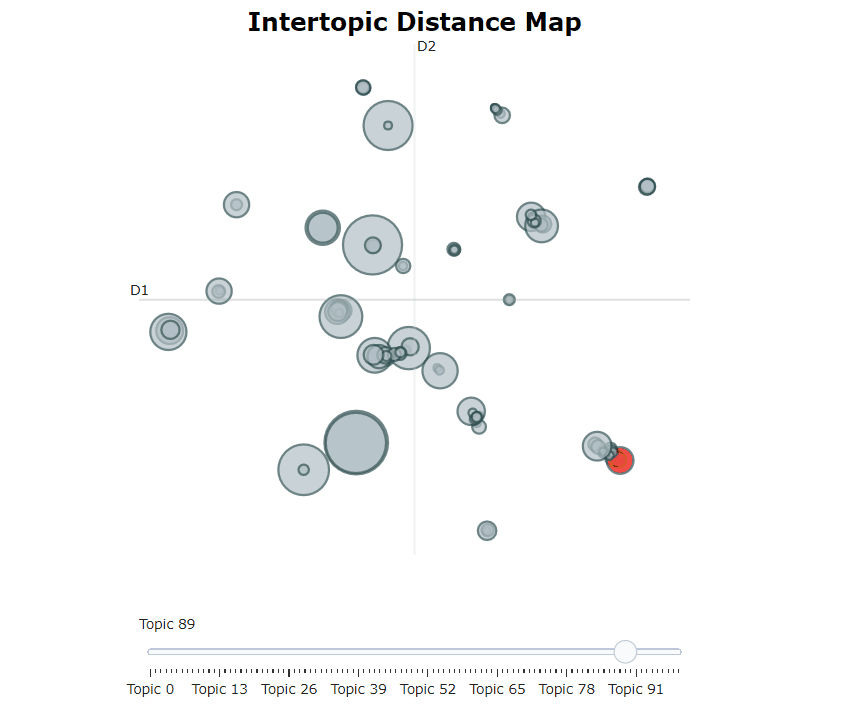MaartenGr / Bertopic
Programming Languages
Projects that are alternatives of or similar to Bertopic
BERTopic

BERTopic is a topic modeling technique that leverages 🤗 transformers and c-TF-IDF to create dense clusters allowing for easily interpretable topics whilst keeping important words in the topic descriptions. It even supports visualizations similar to LDAvis!
Corresponding medium post can be found here and here.
Installation
Installation can be done using pypi:
pip install bertopic
To use the visualization options, install BERTopic as follows:
pip install bertopic[visualization]
To use Flair embeddings, install BERTopic as follows:
pip install bertopic[flair]
Getting Started
For an in-depth overview of the features of BERTopic
you can check the full documentation here or you can follow along
with the Google Colab notebook here.
Quick Start
We start by extracting topics from the well-known 20 newsgroups dataset which is comprised of english documents:
from bertopic import BERTopic
from sklearn.datasets import fetch_20newsgroups
docs = fetch_20newsgroups(subset='all', remove=('headers', 'footers', 'quotes'))['data']
topic_model = BERTopic()
topics, _ = topic_model.fit_transform(docs)
After generating topics and their probabilities, we can access the frequent topics that were generated:
>>> topic_model.get_topic_freq().head()
Topic Count
-1 7288
49 3992
30 701
27 684
11 568
-1 refers to all outliers and should typically be ignored. Next, let's take a look at the most
frequent topic that was generated, topic 49:
>>> topic_model.get_topic(49)
[('windows', 0.006152228076250982),
('drive', 0.004982897610645755),
('dos', 0.004845038866360651),
('file', 0.004140142872194834),
('disk', 0.004131678774810884),
('mac', 0.003624848635985097),
('memory', 0.0034840976976789903),
('software', 0.0034415334250699077),
('email', 0.0034239554442333257),
('pc', 0.003047105930670237)]
NOTE: Use BERTopic(language="multilingual") to select a model that supports 50+ languages.
Visualize Topics
After having trained our BERTopic model, we can iteratively go through perhaps a hundred topic to get a good
understanding of the topics that were extract. However, that takes quite some time and lacks a global representation.
Instead, we can visualize the topics that were generated in a way very similar to
LDAvis:
topic_model.visualize_topics()

Embedding Models
The parameter embedding_model takes in a string pointing to a sentence-transformers model,
a SentenceTransformer, or a Flair DocumentEmbedding model.
Sentence-Transformers
You can select any model from sentence-transformers here
and pass it through BERTopic with embedding_model:
from bertopic import BERTopic
topic_model = BERTopic(embedding_model="xlm-r-bert-base-nli-stsb-mean-tokens")
Or select a SentenceTransformer model with your own parameters:
from bertopic import BERTopic
from sentence_transformers import SentenceTransformer
sentence_model = SentenceTransformer("distilbert-base-nli-mean-tokens", device="cpu")
topic_model = BERTopic(embedding_model=sentence_model)
Flair
Flair allows you to choose almost any embedding model that
is publicly available. Flair can be used as follows:
from bertopic import BERTopic
from flair.embeddings import TransformerDocumentEmbeddings
roberta = TransformerDocumentEmbeddings('roberta-base')
topic_model = BERTopic(embedding_model=roberta)
You can select any 🤗 transformers model here.
Custom Embeddings
You can also use previously generated embeddings by passing it through fit_transform():
topic_model = BERTopic()
topics, _ = topic_model.fit_transform(docs, embeddings)
Dynamic Topic Modeling
Dynamic topic modeling (DTM) is a collection of techniques aimed at analyzing the evolution of topics over time. These methods allow you to understand how a topic is represented across different times. Here, we will be using all of Donald Trump's tweet so see how he talked over certain topics over time:
import re
import pandas as pd
trump = pd.read_csv('https://drive.google.com/uc?export=download&id=1xRKHaP-QwACMydlDnyFPEaFdtskJuBa6')
trump.text = trump.apply(lambda row: re.sub(r"http\S+", "", row.text).lower(), 1)
trump.text = trump.apply(lambda row: " ".join(filter(lambda x:x[0]!="@", row.text.split())), 1)
trump.text = trump.apply(lambda row: " ".join(re.sub("[^a-zA-Z]+", " ", row.text).split()), 1)
trump = trump.loc[(trump.isRetweet == "f") & (trump.text != ""), :]
timestamps = trump.date.to_list()
tweets = trump.text.to_list()
Then, we need to extract the global topic representations by simply creating and training a BERTopic model:
from bertopic import BERTopic
model = BERTopic(verbose=True)
topics, _ = model.fit_transform(tweets)
From these topics, we are going to generate the topic representations at each timestamp for each topic. We do this
by simply calling topics_over_time and pass in his tweets, the corresponding timestamps, and the related topics:
topics_over_time = model.topics_over_time(tweets, topics, timestamps)
Finally, we can visualize the topics by simply calling visualize_topics_over_time():
model.visualize_topics_over_time(topics_over_time, top_n=6)

Overview
| Methods | Code |
|---|---|
| Fit the model | topic_model.fit(docs]) |
| Fit the model and predict documents | topic_model.fit_transform(docs]) |
| Predict new documents | topic_model.transform([new_doc]) |
| Access single topic | topic_model.get_topic(12) |
| Access all topics | topic_model.get_topics() |
| Get topic freq | topic_model.get_topic_freq() |
| Get all topic information | topic_model.get_topic_info() |
| Visualize Topics | topic_model.visualize_topics() |
| Visualize Topic Probability Distribution | topic_model.visualize_distribution(probabilities[0]) |
| Update topic representation | topic_model.update_topics(docs, topics, n_gram_range=(1, 3)) |
| Reduce nr of topics | topic_model.reduce_topics(docs, topics, nr_topics=30) |
| Find topics | topic_model.find_topics("vehicle") |
| Save model | topic_model.save("my_model") |
| Load model | BERTopic.load("my_model") |
| Get parameters | topic_model.get_params() |
Citation
To cite BERTopic in your work, please use the following bibtex reference:
@misc{grootendorst2020bertopic,
author = {Maarten Grootendorst},
title = {BERTopic: Leveraging BERT and c-TF-IDF to create easily interpretable topics.},
year = 2020,
publisher = {Zenodo},
version = {v0.5.0},
doi = {10.5281/zenodo.4430182},
url = {https://doi.org/10.5281/zenodo.4430182}
}





